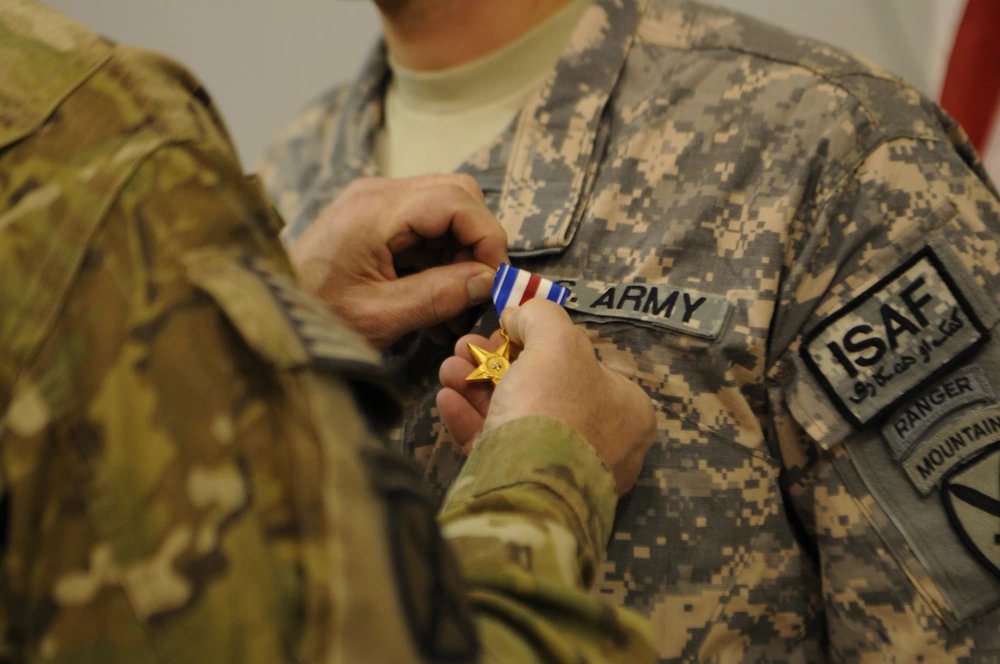

As the third-highest award for bravery in combat awarded to service members in the military, the Silver Star honors those who display exceptional courage while engaged in military combat operations against enemy forces. When you see a Silver Star distinction on a license plate or on a uniform, you might wonder what the service member did to earn the distinction.
Here’s everything you need to know about the Silver Star Medal but didn’t want to ask.
The Silver Star Requirements
The SSM is awarded for bravery, as long as the action doesn’t justify the award of one of the next higher valor awards (the Distinguished Service Cross, the Navy Cross, the Air Force Cross or the Coast Guard Cross).
The act of bravery has to have taken place while in combat action against an enemy of the United States while involved in military operations that involve conflict with an opposing foreign force. It can also occur while serving with a friendly force engaged in an armed conflict against an opposing armed force in which the United States is not a belligerent party.
This medal is awarded for singular acts of heroism over a brief period, such as one to two days.
Exceptions
Air Force pilots, combat systems officers and Navy/Marine naval aviators/flight officers are often ineligible to receive the award after becoming an ace (having five or more confirmed aerial kills). However, the last conflict to produce aces was the Vietnam War, and during that conflict, several Silver Stars were awarded to aces.
Finely constructed details
The Silver Star Medal is a gold five-pointed star, 1 ½ inch in diameter with a laurel wreath encircling rays forming the center. A smaller, 3/16 inch silver star is superimposed in the center. The pendant is suspended from a rectangular shaped metal loop with rounded corners.
On the backside, the reserve has the inscription, “For Gallantry in Action.” The ribbon measures 1 3/8 inches wide and has a 5.6mm wide Old Glory Red stripe in the center, proceeding outward pairs of white and ultramarine blue.
Second and subsequent awards are denoted by bronze or silver oak leaf clusters in the Air Force and Army, and gold and silver stars for the Navy, Marines, and Coast Guard.
Recipients of Silver Star Medals

To date, independent groups estimate that between 100,000 and 150,000 Silver Stars have been awarded since the decoration was established. The Department of Defense doesn’t keep records for how many are issued.
The first Silver Star was awarded to Gen. Douglas MacArthur in 1932, who was then awarded Silver Stars seven additional times for his actions in WWI.
Col. Davis Hackworth was awarded 10 Silver Star medals for his actions in both Korea and Vietnam. It’s thought that he has the highest number of medals issued to one single person.
Former Secretary of State Alexander Haig, Senator John Kerry, Army Gen. George Marshall and Marine Lt. Col. Oliver North all received the award.
WWI Controversy
In WWI, three Army nurses were cited with the Citation Star for their bravery in attending to wounded service personnel while under artillery fire in July 1918. However, in 2007, it was discovered that the nurses never received their awards. These three nurses were Jane Rignel, for her bravery in giving aid to the wounded while under fire, and Irene Robar and Linnie Leckrone, for their courage to attend to the wounded while under artillery bombardments.
The first woman to receive both the Silver Star and the Purple Heart was also an Army nurse – Lt. Col. Cordelia Cook. She served in WWII and later went on to have a career as a civilian nurse.
In 2005, Army National Guard Sgt. Leigh Ann Hester received the Silver Star for her gallantry during an insurgent ambush on a convoy in Iraq. In 2008, Army Spec. Monica Lin Brown received the Silver Star for her extraordinary heroism as a medic in the War in Afghanistan.
Since September 11, 2001, the Silver Star has been awarded to service members during combat operations in Afghanistan and Iraq.
